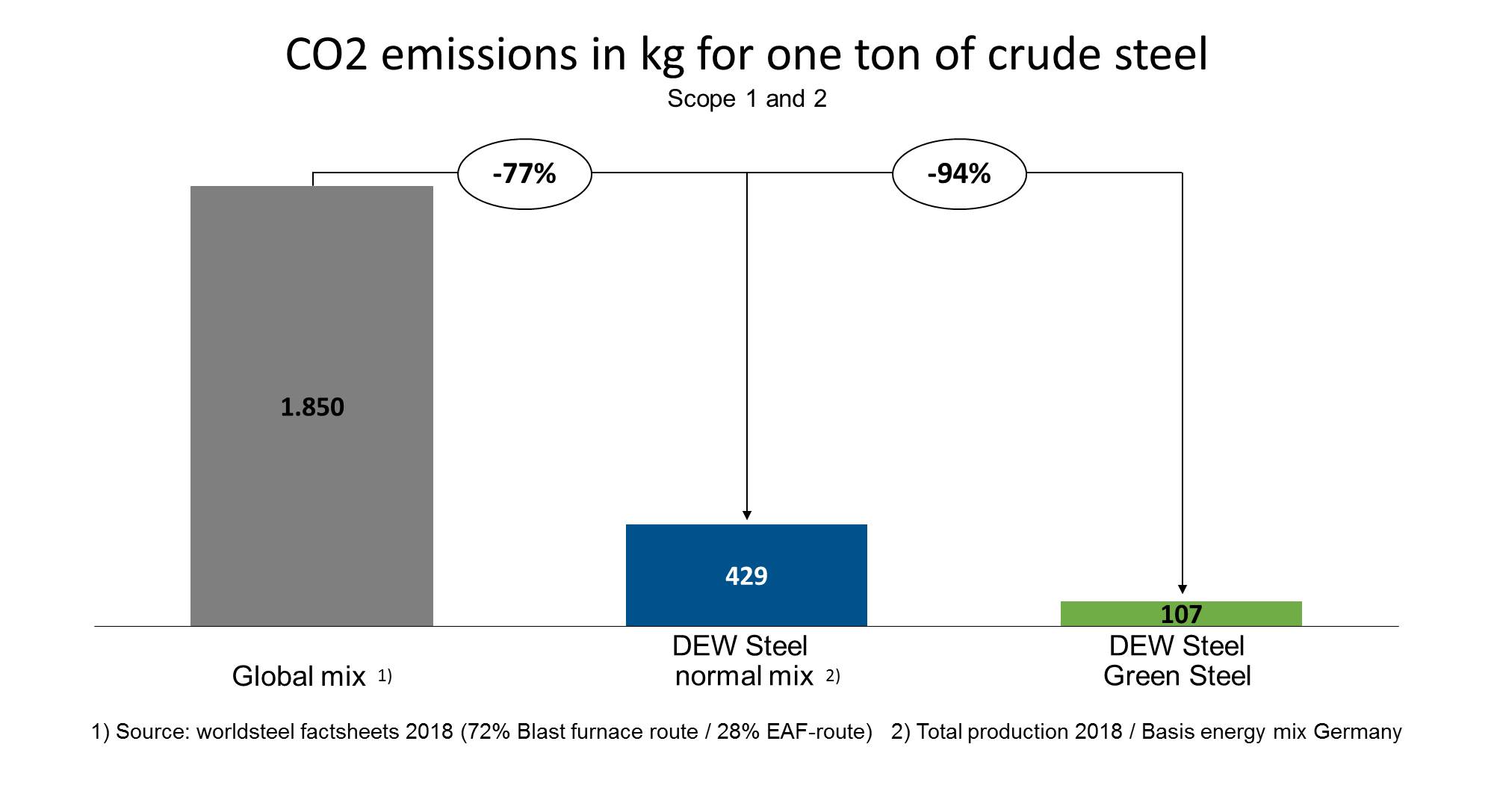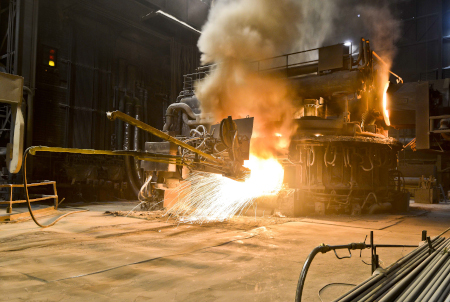No material is as substainable as steel. All the more reason why green steel is one of the main topics for the steel industry in the new decade. However, competences and technical possibilities have reached different levels of development across the sector. One of the pioneers in the manufacture of green steel is Deutsche Edelstahlwerke (DEW). The company in the SCHMOLZ + BICKENBACH Group offers its customers solutions that are low on CO2.
The key question is: what contribution do “green” long steel products make to the circular economy and to resource efficiency? In order to answer this question in depth and continue to develop corresponding solutions, DEW are working closely with their customers – also to develop sustainable recycling concepts. Producing steel in a sustainable manner and significantly reducing the CO2 footprint is the aim. Fundamental to this is the use of renewable forms of energy, such as green electricity. In this way, by using 100 % purely renewable electrical energy, it is possible for DEW to produce a tonne of crude steel with only 107 kg of CO2. In comparison: the worldwide average CO2 emissions for a tonne of steel is 1,850 kg.
“At Deutsche Edelstahlwerke we have been working for years on reducing our CO2 emissions,” says Max Heumann, Head of Plant Engineering at Deutsche Edelstahlwerke. “Even today, due to the process, the steel produced by DEW is much better than the worldwide average in terms of its carbon footprint. In addition, CO2 emissions are being reduced by various projects. Ultimately, not only will our production become more sustainable, but the end product made by our customers itself will leave behind a much lower ecological footprint.”
DEW are achieving this by means of the following methods and concepts, among others:
Scrap metal and scrap concepts
The production of green steel starts with the selection of the scrap metals to be used. Because as a recycled material, scrap steel is the basis for the manufacture of steel. Since DEW predominantly uses scrap for the production of steel, the afore-mentioned close working relationship with customers culminates in individual concepts. For example, scrap metal is fed directly from the customer into the scrap cycle. As steel can be recycled 100 %, corresponding concepts make an essential contribution to the worldwide conservation of resources. For example, DEW are constantly putting their concept to the test together with their raw material company, dhi. It is based on an intensive exchange between the steelworks and the raw material company with the aim of optimizing the use of scrap for the steelworks. Over 100 scrap metal groups lead to alloying elements being fed to the steel smelting works in a resource-friendly manner. Further improvements have been achieved through unitization and by means of the “cleanliness” of the scrap: both parameters have been used to lower the energy demand in the steelworks for smelting steel. Further CO2 savings are being achieved by a national procurement system for scrap metal. A scrap collection system available across Germany means that DEW avoid long transport routes. This makes an additional contribution to preventing CO2 emissions when transporting the raw materials for steel production. The parts of the puzzle thereby come together to lower emissions permanently and noticeably.
The electric arc furnace
For the production of green steel, the electric steel process is seen as the trailblazer in terms of carbon emissions, as this method causes the lowest CO2 emissions. DEW have been well positioned here for decades, as only electric arc furnaces are used at all steelworks operated by the SCHMOLZ + BICKENBACH subsidiaries (Witten and Siegen). In comparison to the blast furnace route, this type of manufacture is more flexible and environmentally friendly. In 2018, DEW emitted 429 kg of CO2 during the production of one tonne of crude steel. This value is based on the average production of all materials made by DEW. As described above: as a worldwide average of all steel producers (blast furnace route and electric steelworks), 1,850 kg of CO2 were released per tonne of crude steel in 2018. DEW was therefore 77 % below the average back in 2018. In this context, DEW will push the use of green electricity in future in order to further reduce the CO2 emissions for the production of all steel solutions. Because the procurement of green electricity can make a significant difference once again in the carbon footprint, as shown by the previously mentioned comparative value of just 107 kg of CO2 emissions per tonne of crude steel compared to the already low figure of 429 kg at DEW. That means a reduction of 94 % compared to worldwide crude steel production.
Special steel solutions for reducing CO2
The most successful steel developments by DEW include the BAINIDUR® steels, as hardly any other steel grade is able to combine cost efficiency and flexibility in such a way. High strength and ductile components for lightweight automotive construction, for example, can be produced with BAINIDUR® reliably, without distortion and as a result with less machining allowance. This makes the bainitic material a future-oriented alternative to conventionally used steel solutions. Customer benefits are a shortened process chain and a constantly reproducible high quality of high-performance, high strength lightweight components.
 BAINIDUR® shows off its strengths especially in the area of green steel, as it demonstrably helps customers to save on CO2 emissions. The energy efficient BAINIDUR® steels are based on the principle of setting the bainitic structure directly from the forging heat without additional heat treatment, thus saving on process costs for the customer and, in turn, on CO2 . In short: thanks to BAINIDUR®, DEW save their customers an extra heat treatment. The steels can replace conventional heat-treatable steels (with the same or improved properties). By increasing the component strength, both the component size and weight can be reduced.
BAINIDUR® shows off its strengths especially in the area of green steel, as it demonstrably helps customers to save on CO2 emissions. The energy efficient BAINIDUR® steels are based on the principle of setting the bainitic structure directly from the forging heat without additional heat treatment, thus saving on process costs for the customer and, in turn, on CO2 . In short: thanks to BAINIDUR®, DEW save their customers an extra heat treatment. The steels can replace conventional heat-treatable steels (with the same or improved properties). By increasing the component strength, both the component size and weight can be reduced.
The initiative “Massiver Leichtbau (Lightweight Forging)”
DEW is a member of the ”Lightweight Forging initiative, which has set the goal of reducing weight on cars and lightweight commercial vehicles and thereby lowering fuel consumption. This also helps to reduce CO2 emissions. In the first phase, the powertrain was determined with 399 kg of steel. With a factor of 2 for using crude steel, it would be possible to reduce approx. 260 kg of CO2 per powertrain with green steel. The new ALUDUR® steels produced by DEW plays a part in this context. These are high-alloyed engineering steels. Compared to conventional steels like 42CrMo4, the high aluminum content in ALUDUR® enables its specific weight to be reduced by approx. 13 %. Used in the automotive sector, further CO2 emissions can be saved due to the significant weight reduction.
DEW part of the energy efficiency initiative
Last but not least, Deutsche Edelstahlwerke launched a special program aimed at energy efficiency back in 2009. It includes more than 75 projects, such as measures to utilize waste heat, a more efficient way of supplying compressed air, measures in the area of lighting and factory heating, and improvements concerning controls/regulations on various facilities. By this means, energy consumption at the company was reduced in recent years by almost 100 million KWh/a and hence CO2 emissions were lowered by around 30,000 t/a. Work is continuously been undertaken to improve this energy efficiency. In addition, DEW have introduced an energy management system according to DIN ISO 50001. Measures that have already been acknowledged in the public sector too: As early as 2010, Deutsche Edelstahlwerke received the renowned environmental prize by the Stiftung Arbeit und Umwelt (Work and Environment Foundation).

